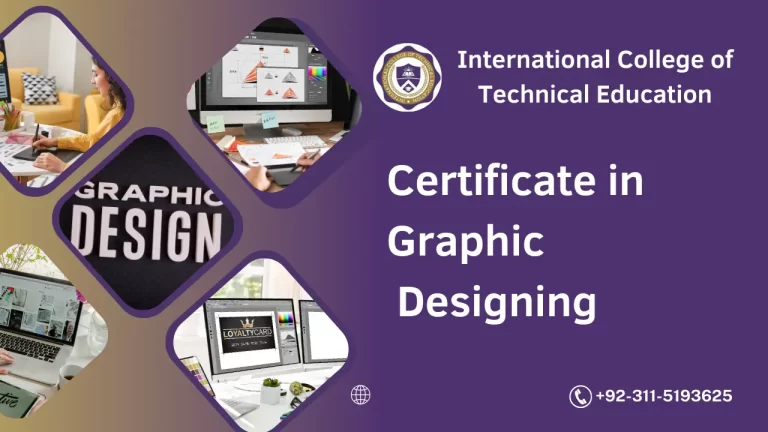The Graphic Designing Course is designed to equip students with a comprehensive understanding of the principles and techniques involved in creating visually compelling and effective designs. This course covers a wide range of topics, from the fundamentals of design theory to the practical application of industry-standard software tools. Students will learn to communicate messages through visual elements and develop a portfolio showcasing their creative and technical skills in graphic design.
Course Benefits:
Upon completion of the Graphic Designing Course, students will gain the following benefits:
- Skill Development: Acquire practical skills in using design software and tools, enabling you to create professional-level designs.
- Creative Expression: Learn how to channel your creativity and ideas into visual forms that effectively communicate messages.
- Industry Relevance: Gain insight into current design trends, best practices, and industry standards, making you a competitive graphic designer.
- Portfolio Development: Build a diverse portfolio that demonstrates your design abilities to potential employers or clients.
- Career Opportunities: Open doors to various career paths in graphic design, such as web design, advertising, branding, and more.
- Freelancing Possibilities: Acquire the skills needed to start a freelance design career and work on a variety of projects.
Course Learning Outcomes:
By the end of this course, students will be able to:
- Understand the fundamental principles of design, including layout, typography, color theory, and composition.
- Apply design concepts to create visually appealing designs for print and digital media.
- Utilize industry-standard design software, such as Adobe Photoshop, Illustrator, and InDesign, proficiently.
- Develop a critical eye for evaluating and critiquing designs based on aesthetic and communicative principles.
- Create logos, brochures, posters, websites, and other design materials for different purposes.
- Incorporate user experience (UX) and user interface (UI) design principles into their work.
- Effectively communicate ideas and concepts through visual storytelling.
- Understand the basics of branding and how to create consistent visual identities.
- Collaborate with clients and team members to meet design requirements and objectives.
- Compile a professional design portfolio that showcases a variety of projects and skills.
Course Study Units:
- Introduction to Graphic Design
- Evolution of graphic design
- Importance of visual communication
- Design Fundamentals
- Elements of design: line, shape, color, texture, and form
- Principles of design: balance, contrast, emphasis, unity, and more
- Typography
- Understanding typefaces and fonts
- Type hierarchy and readability
- Typographic composition
- Color Theory
- Color models and systems
- Color psychology and symbolism
- Creating harmonious color schemes
- Digital Imaging with Photoshop
- Image editing and manipulation
- Photo retouching and enhancement
- Creating digital artwork
- Vector Graphics with Illustrator
- Creating and editing vector graphics
- Logo design and illustration
- Infographics and iconography
- Layout and Print Design with InDesign
- Page layout techniques
- Designing for print materials
- Preparing files for print
- Web and Interactive Design
- Basics of web design and user experience (UX)
- Designing responsive interfaces
- Introduction to HTML and CSS for designers
- Branding and Identity Design
- Building brand identities
- Logo design and visual consistency
- Brand style guides
- Portfolio Development
- Showcasing work effectively
- Tailoring the portfolio for different audiences
- Self-promotion and networking
Entry Requirements: To enroll in the Graphic Designing Course, students should meet the following requirements:
- High school diploma or equivalent qualification
- Basic computer literacy
- Creativity and an interest in visual design
- No prior design experience is required, but familiarity with design concepts is a plus.
Future Progressions: Upon completing the Graphic Designing Course, graduates can pursue several avenues for career growth and development:
- Graphic Designer: Work with various clients and industries to create designs for print, web, and digital media.
- Web Designer: Specialize in creating user-friendly and visually appealing websites and interfaces.
- UI/UX Designer: Focus on designing user interfaces and enhancing user experiences for digital products.
- Art Director: Lead design teams, manage projects, and ensure the overall visual consistency of campaigns.
- Freelance Designer: Work independently on a variety of projects, building a diverse portfolio and client base.
Overall, the Graphic Designing Course provides a solid foundation for those aspiring to enter the dynamic world of graphic design, equipping students with the skills, knowledge, and confidence to succeed in this creative field.






